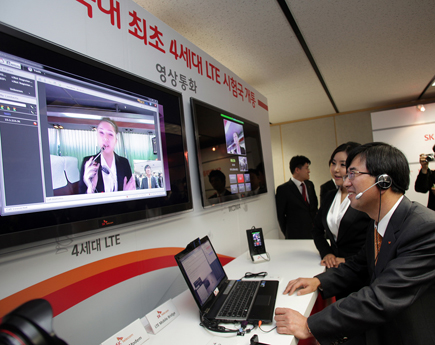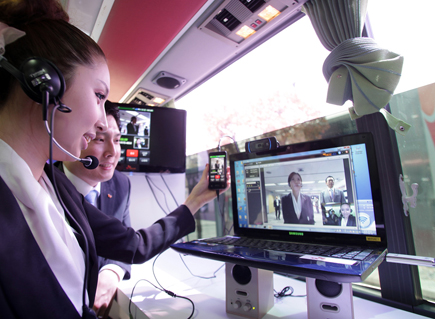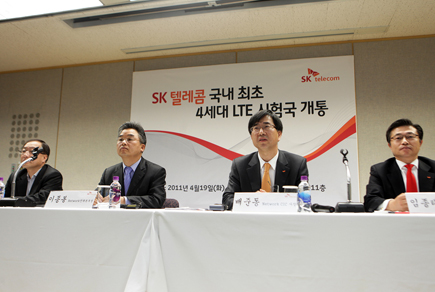content area
Press Release
SK Telecom Demonstrates 4G LTE for the First Time in Korea
2011.04.19 Plans to secure a rich 4G LTE handset lineup – smartphones, tablet PCs, data modem, etc. – within the second half of 2011
Opens an era of high-definition/3D video content via wireless networks
Dramatically reduces time required to download a 800MB movie (to 1 min. 25 sec.) via LTE networks, which is 5~7 times faster than 3G networks
Plans to achieve Korea’s first LTE commercialization in July 2011 and to upgrade LTE networks to LTE-A in 2013
Aims to offer differentiated service quality from the initial stage of LTE service by adopting a cloud-based network technology, CoMP technology and the world’s first LTE femtocell, while also utilizing 2G repeaters
SK Telecom (NYSE: SKM) today held a 4G LTE network demonstration for the first time in Korea at its Bundang Building’s LTE Test-bed to showcase its leading technological expertise based on which the company will introduce innovative LTE services in July 2011.
At the 4G LTE network demonstration, the company compared speeds of 4G LTE and 3G WCDMA; showcased LTE-based 3D video streaming and high definition video content download/ streaming; and demonstrated high definition video call between two handsets, one located in a moving bus and the other in the Bundang Building.
As SK Telecom launches 4G LTE demonstration and makes full-fledged preparations to launch commercial LTE service in July, the Korean market for wireless data service will see a great rise in demand for high-definition content and multi-player network games.
SK Telecom has made great contributions to the growth of the handset and telecommunications equipment industries in Korea by commercializing 2G CDMA and 3G WCDMA (mobile phone-based HSDPA) for the first time in the world. The company once again leads the way by being the first in Korea to demonstrate 4G LTE, the most effective technology to handle soaring data traffic, thereby helping the Korean ICT industry – i.e. large-volume content, next generation applications, etc. – make a leap forward and open new markets for LTE handset and equipment.
LTE is suitable for large volume, real time data service; interconnects seamlessly with existing WCDMA networks; and will create rapidly growing markets for equipment, handset and chipset.
Faced with the global surge in data traffic, as of April 2011, 16 mobile carriers in 13 different countries have already commercialized LTE. Verizon Wireless and AT&T of the U.S., Vodafone and TeliaSonera of Europe and Japan’s NTT DoCoMo have launched commercial LTE service in major cities. Moreover, 56 operators including China Mobile are currently conducting commercial test of LTE networks. LTE is expected to become rapidly deployed from 2012 when the LTE-based smartphones and tablet PCs are released in full swing.
SK Telecom plans to begin providing commercial 4G LTE services in Seoul in July this year and upgrade its LTE networks to LTE-Advanced (LTE-A), the technology standard of which is expected to be completed by June 2011. The pace of this network evolution will be flexibly implemented, taking account customers’ demand for data.
■ Guaranteeing differentiated service quality from the early stage
Adding to its history of leading evolution of mobile networks, SK Telecom plans to offer high quality LTE service by applying its own technological expertise.
First, SK Telecom will adopt its own cloud-based network technology named Smart Cloud Access Network (SCAN) to set up its LTE network. With SCAN, SK Telecom successfully separated Digital Unit (DU) and Radio Unit (RU), the two main components of a base station. DUs will be stored together in one area, while Remote Radio Units (RRU) - along with the antenna - will be set up in various locations, thereby enhancing network operation efficiency. Also, with full-fledged application of cloud computing technology, the network will be able to flexibly and seamlessly handle mobile data traffic that varies by time and region.
Second, the company announced early application of Coordinated Multi-Point (CoMP) technology to its LTE network. CoMP will prevent base station interference and abrupt call disconnections in coverage boundary areas by enhancing signal strength, the lack of which leads to significant drop in data transmission speed. Most mobile carriers are planning to adopt this technology to LTE-A networks.
Third, SK Telecom will pursue early development of LTE femtocell to enhance underground and indoor coverage of its LTE networks. 3G femtocell is currently being applied to the company’s networks to improve voice and data quality.
Lastly, SK Telecom will provide flawless coverage from the early stage of LTE roll-out by utilizing widespread 2G repeaters as it plans to provide LTE service in the 800MHz frequency band, which it used for 2G (CDMA) service. Since the beginning of its 2G service, the company has been operating many repeaters - equipment that repeats radio signals to enable seamless communication - installed throughout the city center including inside of buildings. Thus, utilization of 2G (800MHz) repeaters will allow 4G LTE service users to enjoy seamless service from the initial stage just like the users of 2G service.
■ Aiming for mutual growth with other companies to once again create a virtuous ecosystem
SK Telecom plans to launch ’LTE data modem handsets’ in July this year at the time of LTE commercialization and expand its LTE handset lineup to smartphones and tablet PCs within the second half of 2011.
The company will offer LTE-based data services by releasing diverse LTE smartphones and respond to the needs of heavy data users through early provision of tablet PCs.
Throughout its history, SK Telecom has contributed to the creation of a virtuous cycle within the ICT industry as its early establishment of networks promoted the advancement of handset quality and equipment technology, which then led to the growth of the content market. SK Telecom is committed to once again play its due role as the top mobile carrier in Korea via early roll-out of LTE networks so as to achieve mutual growth with handset makers, equipment companies and content providers.
■ Ushering in the era of high definition content
SK Telecom’s LTE roll-out is expected to boost high resolution, large volume content services as well as rich communication services.
Content consumption, which is currently focused on music, is expected to expand to video. With LTE, the company will be able to provide smooth download of high definition VOD and seamless streaming service, thus realizing the N-screen era. Moreover, video consumption is expected to switch from 400-500MB standard-definition (SD) video to 700-900MB high definition (HD) video content.
The company will also be able to offer seamless, high quality video call service via LTE networks. The existing 64Kbps video call will be improved to over 500Kbps, thereby enhancing image quality by 8 times and voice quality by more than 2 times. The service will be available as early as second half of 2011.
In addition, mobile games will become as widespread and abundant as web games. Large volume fancy graphic games and simultaneous multiplayer games, in particular, are expected to be actively played among users.
Furthermore, LTE will add sophistication and accuracy to location-based services (LBS). SK Telecom plans to launch an upgraded version of its T Map service, through which customers are given much more detailed and precise maps and even photos of nearby trade areas.
■ Aiming to upgrade Korea’s telecommunications networks by evolving to LTE-A in 2013
SK Telecom, a proven leader in the area of network evolution, plans to further solidify its status as the representative telecommunications provider in Korea through its successful roll-out of 4G LTE that paves the way for high-definition video content.
SK Telecom realized the popularization of mobile telecommunications in Korea by offering world’s first commercial CDMA (2G) service and pioneered the era of video call in 2000 with the adoption of CDMA2000 1X. Moreover, in 2006, it introduced mobile data communication by commercializing mobile phone-based WCDMA (HSDPA) for the first time in the world. As of April 2011, SK Telecom is offering HSPA+, the fastest 3rd generation telecommunications technology the company started providing in the second half of last year, in 41 cities across the country including Seoul.
4G LTE offers up to 75Mbps downlink speed and 37.5Mbps uplink speed on 10 MHz of spectrum, which are, respectively, 5 and 7 times faster than the existing 3G WCDMA networks. For instance, the 7 minutes and 24 seconds, which is the time required to download an 800MB movie via WCDMA networks, will be dramatically shortened to 1 minute and 25 seconds via LTE networks.
SK Telecom said that today marks the beginning of its full-fledged efforts to build LTE networks to commercialize the service in July. The company plans to expand its LTE coverage to 23 cities including the Seoul Metropolitan Area and other Metropolitan cities as soon as possible and provide nationwide coverage (82 cities) in 2013. Moreover, SK Telecom unveiled plans to upgrade LTE networks to LTE-A networks in 2013 to further enhance data communications speed and capacity.
SK Telecom added that once fully commercialized, LTE will be able to handle 3 times more data traffic on 10 MHz of spectrum compared to the existing WCDMA networks thanks to its enhanced speed.




